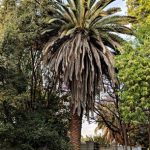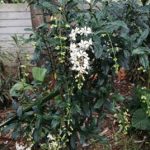TREE LIFE
April 2021
There seems to be a lifting of Covid restrictions, but let us not be complacent. But at the same time we are going to enjoy the outings arranged by Ann Sinclair, in April we have been invited to Jan Teede’s property. And in May we have been invited to Zia Thomas lovely wild garden, so make a note of the dates and lets descend on these two properties with our usual verve and enjoy being out in the sunshine again.
April 18th 2021 at 10a.m. A visit has been planned to Jan Teede’s property on Princess Close which is off Piers Road. Bring you chair, juice, lunch and sun tan lotion and make a day of it. He has got 1500 trees planted and a river running through the property.
May 16th 2021. We have been invited by Zia Thomas to visit their beautiful plot at Trafalgar Avenue at 10.00 a.m. You are invited to bring your lunch and picnic. Directions will be given.
Assegais and apalises: a mystery garden tree revealed
Each year its blossoms create eye-catching clouds of ivory white, and bees visit them in such great numbers that it sounds like a swarm is flying overhead.
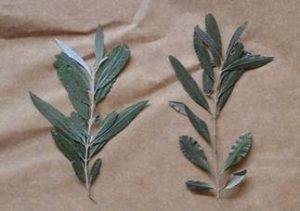
The leaves of the Olive buddleja (left) and the African olive. Photo: Ryan Truscott
The blossoms belong to a tree in our garden whose identity was, until recently, unknown to us.
In January I planned to take photographs when the flowers were at their peak, but a few days of hard rain set in and knocked them off.
At first glance the tree resembles an African olive, Olea europaea, subsp. africana. In fact the person who planted it in our garden long ago must have known that: he/she planted it right next to an African olive.
Their branches mingle above the brick pathway that leads to an outside office. Their similarity should have given me a clue. The mystery tree is in fact a False olive: Buddleja saligna. It is wide spread in South Africa where its heavy wood was once used to make assegai handles.
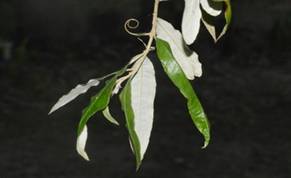
Two toned leaves of the B. saligna are distinctive. Photo: Ryan Truscott
Zimbabwe, where it is known as the Olive buddleja or Olive sagewood, it only occurs in a small area in the south of the country.
My 1977 edition of “Trees of Southern Africa” has a small dark splodge — like the ‘X’ on a treasure map — marking the spot near Bulawayo where the Olive buddleja occurs naturally. I asked the Tree Society’s Meg Coates Palgrave about that.
“Buddleja saligna has quite a wide distribution in South Africa and just creeps into Zimbabwe in the Matobo Hills complex,” she said. “This (the Matobo Hills) appears to be the northern limit of the distribution of B. saligna.”
She said another species of Buddleja, B. salviifolia occurs in the east of the country, while B. dysophylla occurs in South Africa and further north and misses out Zimbabwe altogether.
“B. saligna has obviously been available in nurseries and so quite widely planted in gardens,” she added.
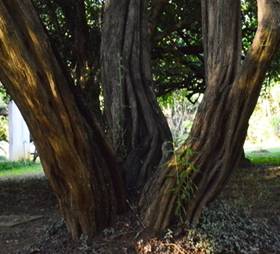
The trunk of the Olive buddleja is highly fluted. Photo: Ryan Truscott
And that must be how one of these trees ended up in our garden. But how did I finally come to identify it?
I owe it to the two Van Wyks, Braam and Piet. Their book, “Field Guide to Trees of Southern Africa” has trees arranged in groups. And since the Tree Society committee was recently encouraged by a member to consider organising a bit of tree sleuthing using these groups, I looked in the sections that group trees with simple leaves that are “opposite, subopposite or whorled”.
This narrowed down the search and there, under Group 23, was a picture of our mystery tree.
In addition to being opposite, the leaves of the Olive buddleja are distinctly two-toned, or “discolorous”: darker green on top and much lighter, silvery green below.
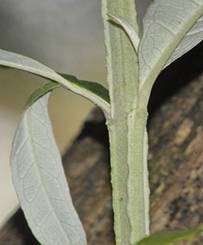
The tender shoots have four angles to them. Photo: Ryan Truscott
Other key features include the shoots, which have four angles to them, and the trunk, which is fluted and gnarled and covered in bark that comes off in strips.
The little cavities in the twisted trunk of our tree are home to spiders’ nests, and insectivorous birds love it. The tinkling calls of Bar-throated apalises can be heard often in its branches.
In Zimbabwe there is no indigenous name for the Olive buddleja that I can find, which would suggest it is not widely-known or used for medicine within local communities.
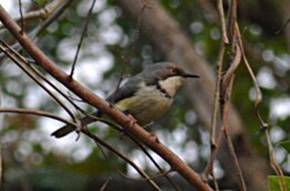
Bar throated apalis is a regular visitor. Photo: RyanTruscott
But elsewhere in southern Africa extracts from the bark and leaves are used to treat everything from colic to coughs, and colds to sore eyes, according to a 2009 study in the journal BMC Complementary and Alternative Medicine.
The authors of that study confirmed the leaves of B. saligna possessed antioxidant and antibacterial properties.
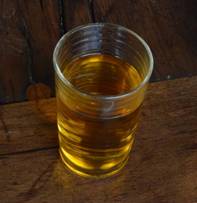
Beautiful amber-coloured liquid that tasted faintly of soyabeans. Photo: Ryan Truscott
I tested the tea-making properties of our tree’s leaves: they produced a beautiful amber-coloured liquid that tasted faintly of soyabeans.
Come January, I look forward to once more witnessing the tree resplendent in sprays of white blossoms. They’re said to be a magnet for moths.
Since the flowers on our tree grow mostly on top of the crown I’ll need to climb onto the office roof with a torch at night to take a look.
I’ll let you know what I find.
-Ryan Truscott
March 2021 tree walk at the National Botanical Garden
The second Covid 19 lockdown has finally eased off allowing us to have our second tree walk of the year to the usual first Saturday of the month venue – The National Botanical Garden.
Present were Jan van Bel, Mark Hyde, Meg Coates Palgrave, Dawn Siemers, Marina Mason, Jim Dryburg, Karl van Laeren, Teig Howson, Sean Lightfoot, myself and new members May and Michael Dawes.
The mission was to look at what people call Mahoganies. The true mahoganies belong to the Meliaceae family which includes the genus’s Khaya, Swietenia, Lovoa, Turraea and Trichilia. Afzelia quanzensis. The Pod-mahogany (which is not a mahogany) belongs to the Caesalpinioideae family and as far as I know there are no Afzelia quanzensis or Turraea nilotica in the National Botanical Garden
The first tree we looked at was the Khaya grandifoliola, (which is not indigenous to Zimbabwe) which has common names: African mahogany, Benin mahogany, large-leaved mahogany or Senegal mahogany and like so many other trees is threatened by habitat loss. It occurs north of Zambia mainly in the sub-saharan areas.
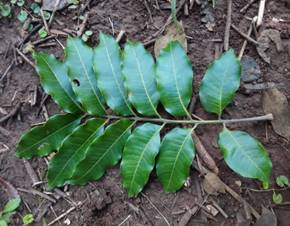
Lovoa swynnertonii leaf. Photo: Tony Alegria
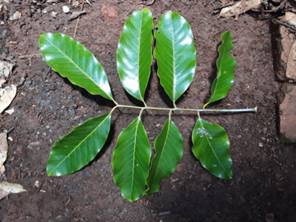
Kyaha grandifoliola leaf. Photo: Tony Alegria
The next tree we looked at was the Swietenia mahogani with some common names being: American mahogany, Cuban mahogany, small-leaved mahogany, and West Indian mahogany. This tree is indigenous to Central America and the Caribbean. This is the tree from which the original mahogany wood was produced and is now grown in plantations.
En route to see the next tree we went through the Medium Altitude Rainforest to find that a huge Albizia gummifera had fallen down and flattened the only Phyllanthus inflatus in the gardens. Within the same area were a few Khaya anthotheca. Red Mahogany. This is the “Big Tree” to be found at Mount Selinda. These trees had no leaves close enough to the ground to be photographed. Also within this area we looked at the Lovoa swynnertonii. Minature wooden-banana. It is also known as brown mahogany or Kilimanjaro mahogany. Although it is indigenous to Zimbabwe it grows further north as can be ascertained from the common names.
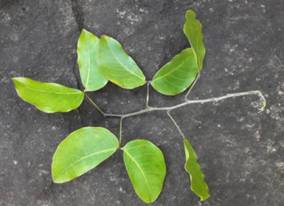
Guibortia coleosperma leaf.Photo: Tony Alegria
We then went to see the Rhodesian mahogany – the Guibourtia coleosperma. Large false mopane, which also belongs to the Caesalpinioideae family. Trees with bifoliate leaves are rather unusual so whilst we were in the area we are looked at a couple of other trees with bifoliate leaves – Guibourtia conjugata. Small false mopane and the Balanites maughamii. Y-thorned torchwood. Of course the best known and widespread bifoliate leaved tree in Zimbabwe is the Colophospermum mopane, Mopane tree.
The last two mahoganies to be looked at were the Trichilia emetica, also known as the Banket Maghony. Natal mahogany and the
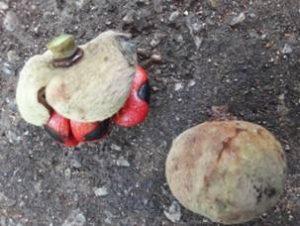
Flattened sphere fruit of the T.dregeana
Photo: Tony Alegria
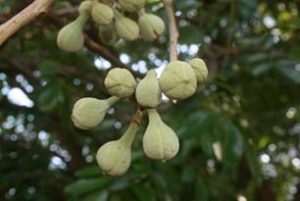
Trichilia emetica fruit showing stalks
Photo by Mark Hyde Flora of Zimbabwe
Trichilia dregeana. Natal forest mahogany which grow side by side right next to the Herbarium. Unfortunately the Trichilia emetica had no fruit but the Trichilia dregeana did have, I say unfortunately because the fruit is diagnostic. By counting the veins on the leaflets, you should be able to identify the tree, but this is rather difficult because there is an overlap in numbers of veins and often you land up in this area.
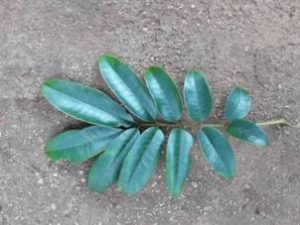
Trichilia emetica leaf. Photo: Tony Alegria
The leaves of the Trichilia dregeana were too high up to get a sample to photograph. Although there are many Trichilia dregeana around the city, this tree has the largest leaves I have seen. The fruit is a flattened sphere and as can be seen from the photo, the T. emetica fruit is rather different in that it is rather pear shaped.
Thus ended a very pleasant morning!
–
-Tony Alegria
PALMS OF HARARE – 2
FOUR MORE PALMS FROM ALEXANDRA PARK, HARARE
In my first article, I described the 9 most common species of palm to be seen in the suburb of Alexandra Park, Harare. In addition to the 9, I have come across a further 4 species, one actually in Gunhill, all of which are much less common.
Before discussing these, a return to the two species of Archontophoenix:
| Archontophoenix alexandrae | King palm |
| Archontophoenix cunninghamiana | Seaforthia palm |
As I mentioned, leaf characters are useful in separating the two and they are mostly out of reach. However, recently I came across short trees in Griffin Road, Gunhill, near the Hall at Dandaro and in Guest Avenue, Alexandra Park, which enabled me to reach the leaves. All 3 specimens had green under surfaces and the ‘chaff’ along the main vein beneath, which told me that they were cunninghamiana. This agrees with Tony Alegria’s opinion that the Seaforthia palm is the commoner of the two species in Harare.
These chaffy bits are known as ramenta, the definition of which reads “irregularly shaped, thin scales, sometimes found along the abaxial midrib of a leaflet”.
Unfortunately, none of the images which I took of the ramenta were good enough. Hopefully, I can try again and add a picture in a later article.
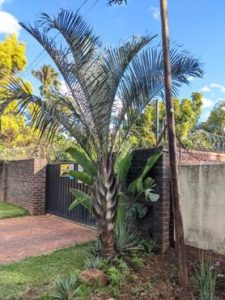
1 – Dypsis decaryi in Harry Pichanick Drive
The first of the 4 species to be discussed is Dypsis decaryi, the Triangle Palm. I have seen this twice in Alexandra Park, once in Harry Pichanick Drive and once in Hodson Avenue.
This is a very distinctive species. The first impression is of long blue or grey-green pinnate leaves which are 3-ranked, radiating in 3 directions. This feature gives the species its common name. The leaf bases are swollen and overlapping, and are pale, almost white. This is a monoecious species; male and female flowers occur together in the same inflorescence.
D. decaryi is endemic to Madagascar and was named for French naturalist Raymond Decary, 1891-1973, who collected the type specimen.
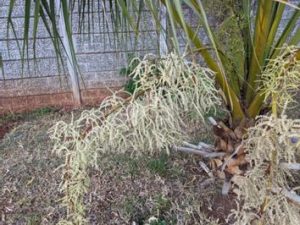
Sabal palmetto inflorescence
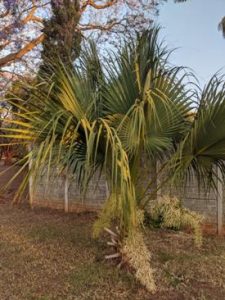
Sabal palmetto. John Plagis Avenue
Sabal palmetto, the Cabbage palm, is another species planted on roadside verges. I have 3 records from the suburb. All three specimens are relatively small, 2-3 m tall, with very large costapalmate leaves. Costapalmate means the leaf is palmate but with the leaf midrib extending into the leaf blade. In this case the extended midrib is noticeably curved. The inflorescence is large, exceeding the leaves, with many creamy-white flowers.
The origin of the name Sabal is uncertain but palmetto is the Spanish for “little palm” white flowers.
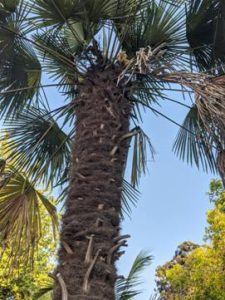
The next species is Trachycarpus fortunei, the Chinese windmill palm. I have only seen one of these in the suburb, visible over the wall in a garden in Helsdon Avenue.
This is a palmate palm, its most distinctive feature being the stem which is covered with matted brown or grey fibres. The inflorescence is congested and densely branched; it is a dioecious plant with male and female flowers on separate trees.
Trachycarpus fortunei Heldson Avenue
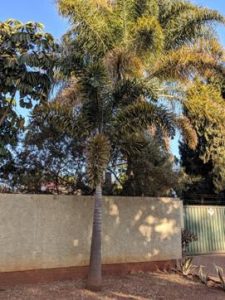
Wodyetia bifurcata, Griffin Road
The final palm in this article is the Foxtail Wodyetia bifurcata, palm. I am actually cheating a little here as the one occurrence is in Griffin Road, on the other side of the Borrowdale Road.
This is a solitary, pinnate-leaved palm. The leaflets spread in several planes, giving a bushy, foxes-tail-like impression and the tips are jagged, looking a bit green crownshaft, from the base of which extend pendulous inflorescences, male and female in separate parts.
Wodyetia bifurcata, Griffin Road. This palm is only known from a small area on Cape Melville in the Cape York Peninsula, north Queensland, Australia. The genus is named after Wad-yeti, an Aboriginal elder with traditional knowledge of the area. The specific name bifurcata means twice-forked and refers to the arrangement of fibres in the fruit. The species was only discovered in the 1980s but has spread rapidly in cultivation.
As a newcomer to the world of palms, I would welcome any comments or corrections.
In the next article, I will extend the scope to include palms seen in other parts of Harare outside my home suburb.
-Mark Hyde
The Rumex puzzle at Epworth and ZimPhos
Secluded railway lines snake through whispering gum plantations and disappear under waving grass and creeping soil. It’s the end of the line for abandoned carriages rusting away at the south dump. Oxidizing 6” pipes pour memories into open air, where honey bees reverse the flow and set up shop.
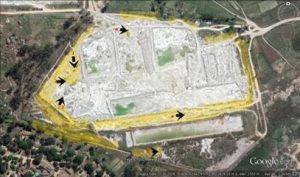
Rumex map
The general dereliction of the area reminds me of the old gold workings on the Witwatersrand; there is that same old, intriguing, ghostly feeling from another era!
You know how it is, how you pass something on a fairly frequent basis but never stop to see what it is? Well, I had been mountain-biking and passed some strange plants for about 6 months, on and off, before I hit the brakes and hauled out the camera. This was in September 2020.
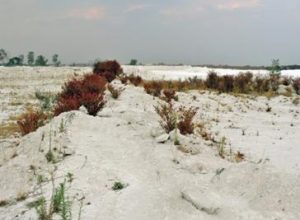
Photo 2 – see map
On the paths along the southwest edge of the southern ZimPhos dump (below photo 3 on the accompanying map showing the extent of growth), and on the dirt road along the northern boundary of Epworth, are some strikingly red bushes – and one, at some 2.5m high, you can call a large shrub.
Mark thought they might be R. nervosus and I uploaded the record on iNaturalist as such. @troos, a participant on iNat, disagreed and suggested the commonly cultivated R. usambarensis.
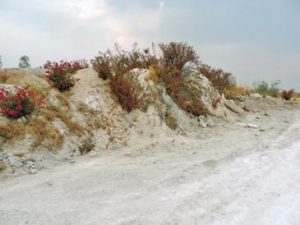
Photo 4 – see map
Rumex spp. are commonly called Docks and belong to the Polygonaceae or buckwheat family; sorrels are also in this family. The Flora of Zimbabwe site lists 8 native and naturalised plants species, plus a 9th, usambarensis as a cultivated one. Rumex nervosus var. usambarensis is listed as a subspecies but this is now a synonym of usambarensis (of the Usambara Mountains, Tanzania) – nervosus isn’t listed on the site. JSTOR and GBIF recognise nervosus as a species and the former describes it as ‘a much-branched shrub, reaching a height of 6ft.’, which more fits the Epworth plants. Neither species is mapped on the Flora of Zimbabwe site, but under cultivated plants usambarensis has photos from Nyika National Park in Malawi; elsewhere usambarensis is mapped on iNat from Cape Province, Gauteng & Mpumalanga, Malawi and Kenya – nervosus is mapped from Ethiopia. It is all a bit confusing and there appear to be different taxonomic treatments for nervosus and usambarensis, which doesn’t help.
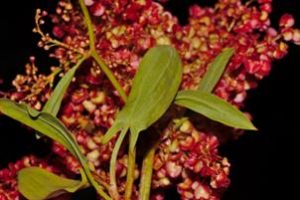
Rumex leaves

Rumex flowers
The Epworth shrubs are interesting plants. The leaves are narrowly elliptic and hastate at the base, an attractive feature I think of as fish-tailed, distinctly 3-veined from the base and hairless. The inner perianths of the flowers are red, and are fully developed in the fruit, enclosing the seed tightly with a papery and persistent, somewhat heart-shaped, 3-winged achene… at least I think these are the final development of the perianths. These wings are strongly reticulately veined. They give the bushes their red colour and later fade to a light brown, though there are usually lots of new fruits present at the same time to keep them looking red.
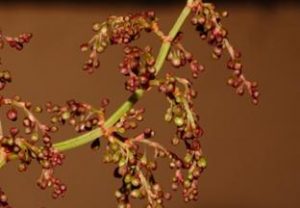
Rumex inflorescence in bud
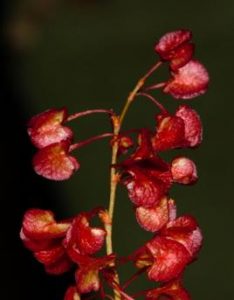
Fruit showing the 3-winged achene
The inflorescence is a much-branched leafless panicle with the small and insignificant flowers in fascicles, on filiform pedicels. Some of my attempts to photograph the budding flowers show the 2-celled anthers emerging. They have no petals but are enclosed by tepals.
Pollination is said to be anemophious (by wind) in Rumex but I did see some heavily pollen-laden bees working the flowers so insect pollination occurs to some degree.
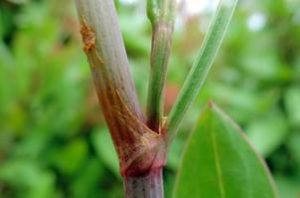
Rumex ochrea
Polygonaceae is also characterised by thellen stem nodes – called ochrea or ocrea, plural ochreæ – and as they wrap around the stem like thin parchment, might not be casually recognised as stipules.
The interesting question is where did they come from? They appear to be limited to this area so I mapped them for Mark’s interest. Investigating further I found only one plant further north on the edge of the next dump and a few plants on the edge of a road north of that, at the base of the ‘purple hill’. Wandering around the Epworth Township to the south there were some plants in drainage ditches and some residents have planted them as small, low hedges. But these give the impression of being more recent than the dump ones and, being downwind and downslope of the dump, I suspect that they have spread from the dump rather than from the houses, many of which have been built fairly recently. There weren’t any in the older established properties nearby, so this supports my theory that they were originally planted near the dump. We clearly need to know more on the history of this spot to solve this mystery.

Fruit showing the 3-winged achene
Recently, on 14th March, I was beetling into town on the Chiremba road. Instead of taking my usual shortcut to the right and along the dirt road that cuts across to the dumps (this was a navigable dirt road last year, but with severe erosion is now only for pedestrian/bicycle use!), I continued along the main road. A little further along I cut across to the other side of the Chiremba road, mainly to get onto a parallel dirt track and get away from the hazardous driving! The track and main road cross a bridge just before Meadow Crescent and this fortuitous route change led me straight to a few sizable Rumex bushes by the stream. This is the stream that has developed from the drainage ditches mentioned above and shows that seeds have washed further down than I had realised, and it’s likely that plants are also in Hatfield on the west side of Chiremba road and on their way into Waterfalls to join the Manyame above Lake Chivero.
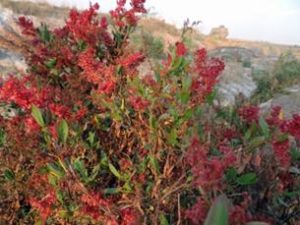
The red fruit on a rumex bush
Also interesting is their habitat preference and that appears to be for disturbed ground. Where they are most prolific is on formerly graded ground, on the ridges thus formed. Some of these are included here, numbered as per the map, and the others can be found on the iNat observations, along with more plant photos, see https://www.inaturalist.org/observations/60853488, https://www.inaturalist.org/observations/70507439, https://www.inaturalist.org/observations/70657683.
Is their growth stimulated by the minerals found here? I presume these dumps are phosphate rich, but exactly what the composition is I can’t say. Perhaps someone knows the origin of these dumps; I doubt they are from local deposits and perhaps are from rock brought in from Dorowa and other areas in the past, because this area is granite after all. The two dumps are being reworked at the moment so there is bound to be some disturbance of the site.
- nervosus leaf meal has been used as a feed additive for broiler chickens during the starter period and leaf extracts show promise with anticoccidial, and anti-inflammatory properties and could be used for the treatment of eimeriosis in chickens. In humans the plant has been used in Saudi Arabia, Yemen, India and Africa in traditional herbal medicines, which has led to investigations of antimicrobial activity of methanol and n-hexane extracts against three pathogenic bacterial strains and one pathogenic fungus – it also has vitamins B1, B2, B12, and folic acid.
All photographs by Ian Riddell
-Ian Riddell
TONY ALEGRIA, CHAIRMAN


